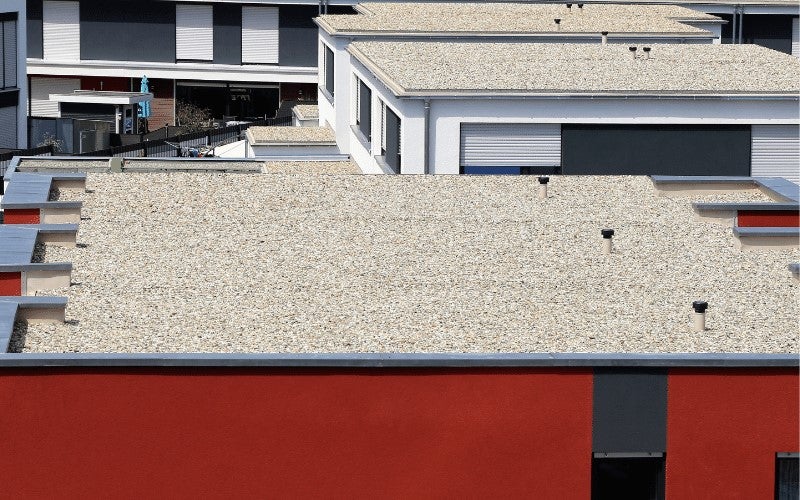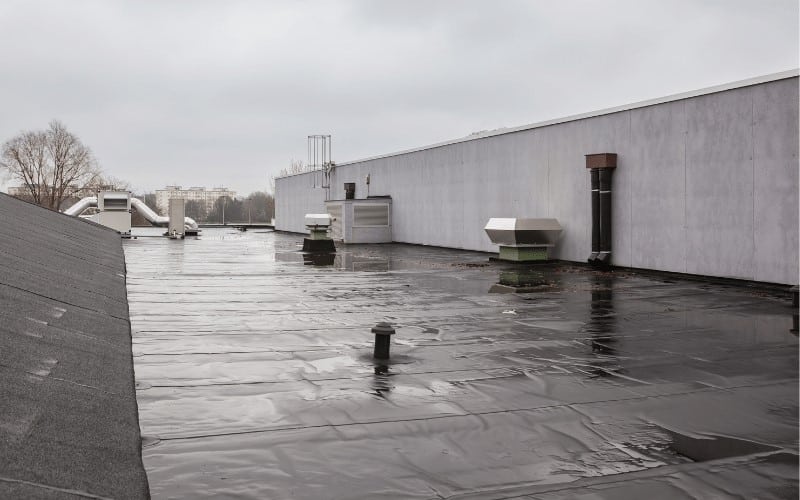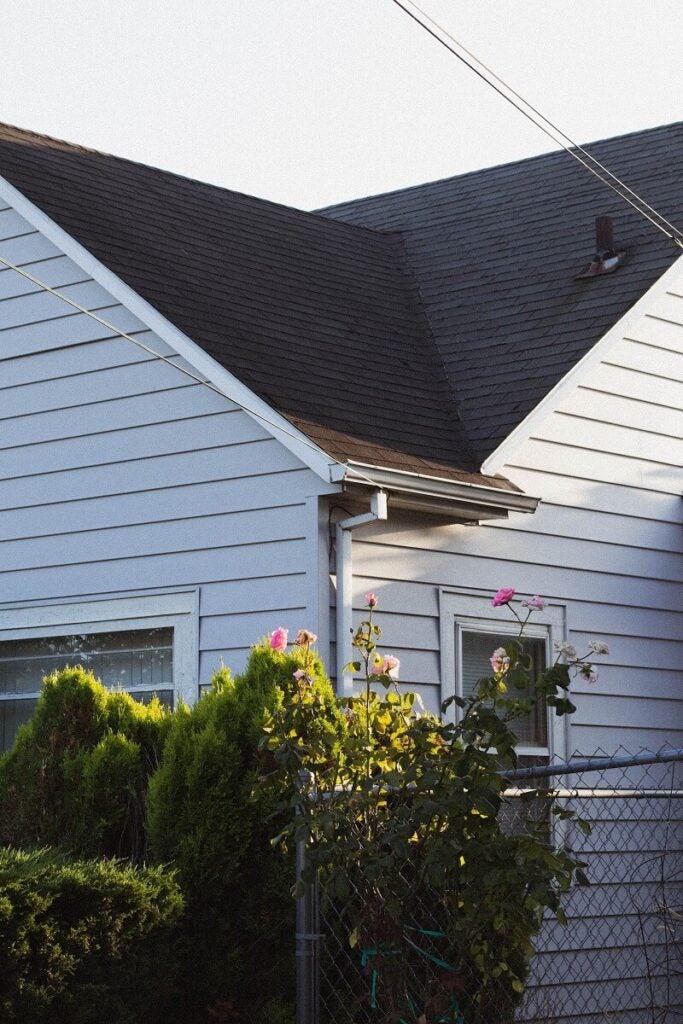For those with flat or low-slope roofs, a roof membrane is often the best defense against water damage. However, with so many roof membrane options available, how does you choose the right one? Below, we’ll delve into the various types of roof membranes, their costs, and factors to consider when selecting the best option for your home.
Find help choosing and installing a new roof membrane using the link below:
What Is a Roof Membrane?
Unlike traditional sloped roofs that rely on gravity to shed water, flat roofs need additional protection to prevent leaks and promote water drainage. A roof membrane is a waterproof layer designed specifically for flat or low-slope roofs. It moves water and moisture off the roof surface to prevent it from entering a building.
Roof membranes come in various materials and forms, including rolls, sheets, and liquid applications, and are installed with adhesives or heat, similar to torch-down roofing. Made from materials such as rubber, plastic, and modified bitumen, roof membranes are durable, cost effective, and easy to install.
Roof Membranes Types
Here are some of the most common available roof membrane types:
Built-Up Roof Membranes

Built-up roof membranes (BUR), often referred to as tar and gravel roofing, are a staple in the roofing industry. They consist of multiple layers of bitumen (usually asphalt or tar) alternated with reinforcing fabrics or felt. The top layer incorporates gravel or stones for added protection.
BUR membranes are known for their durability—they can last 20 to 30 years with proper care.
Modified Bitumen Roof Membranes

Modified bitumen membranes evolved from the traditional BUR system. They use asphalt modified with polymers to enhance elasticity and strength. There are two main types of modified bitumen membranes: styrene-butadiene-styrene (SBS) and atactic polypropylene (APP).
SBS membranes are known for their flexibility and ability to withstand extreme weather conditions. They’re particularly well suited to significant temperature fluctuations, as the material can expand and contract without cracking.
APP membranes offer excellent ultraviolet (UV) resistance, durability, and resilience in the face of high temperatures.
Single-Ply Membranes

Single-ply membranes are gaining popularity due to their ease of installation and relatively low cost. They consist of a single layer of synthetic material and are typically available in large sheets or rolls. There are two types of single-ply roof membranes:
Thermoset
Thermoset membranes, also called elastomeric membranes, are made from synthetic rubber. Combined with a protective layer of chlorosulfonated polyethylene, they stand up to UV light, making them a strong choice in areas with high sun exposure. The most common type, ethylene propylene diene monomer (EPDM), is particularly popular thanks to its long lifespan (30 years or more).
Thermoplastic
Thermoplastic, or plastomeric, membranes include materials such as polyvinyl chloride (PVC) and thermoplastic olefin (TPO). They soften when heated, so they’re easy to install and repair. PVC membranes are highly chemical resistant, making them ideal for manufacturing plants and industrial facilities. TPO roofs are UV resistant and are white, so they reflect sunlight and reduce cooling costs.
Spray Polyurethane Foam Roof Membranes

Spray polyurethane foam (SPF) roofing is a unique option that involves spraying a liquid foam onto the roof surface. This foam expands and hardens, creating a seamless, waterproof layer. SPF roofs have excellent insulation properties and can adapt to irregular roof shapes, making them a versatile choice for many buildings.
A main advantage of SPF roofing is its ability to fill in cracks and crevices, creating a seamless barrier against water infiltration. However, installation must be done carefully, as mistakes can lead to significant damage.
Liquid-Applied Roof Membranes

Use of liquid-applied membranes is increasing, especially for roofs with complex shapes or numerous penetrations. Its liquid coating cures to form a seamless, rubber-like surface.
The main advantage of liquid-applied membranes is their ability to easily seal around protrusions, such as vents or chimneys. They’re also relatively easy to apply and can be a good choice for DIY-inclined homeowners.
Factors To Consider When Choosing a Roof Membrane
To help select the right roof membrane, keep these points in mind:
- Climate and weather conditions: Areas with high UV exposure benefit from membranes with good UV resistance, while regions with extreme temperature fluctuations require more flexible materials.
- Roof slope: All membranes are designed for flat or low-slope roofs, but some are better suited to higher-sloped roofs.
- Foot traffic: If the roof will see frequent foot traffic for maintenance or other purposes, choose a more durable membrane.
- Maintenance: Some membranes are easier to repair than others, which can affect long-term costs.
- Budget: Roof membranes have varying installation costs.
Roof Membrane Costs
The cost of a roof membrane can vary significantly based on the type of material, the roof’s size, and the installation’s complexity. As a general guideline, homeowners can expect to pay between $4 and $14 per square foot, including installation, for most membrane roofing systems.
Here’s a rough breakdown of costs for different membrane types, according to Angi:
- BUR: $4 to $10 per square foot
- Modified bitumen: $4 to $8 per square foot
- EPDM: $5 to $13 per square foot
- TPO: $4 to $14 per square foot
- PVC: $5.25 to $12.50 per square foot
- SPF: $2 to $6 per square foot
Installation and Maintenance
While you might consider tackling roof membrane installation as a DIY project, hiring a professional will give you the best results. The quality of the Installation affects the roof membrane’s longevity and effectiveness, and mistakes can lead to costly repairs.
Maintenance requirements vary depending on the type of membrane. Inspect the membrane twice a year, clear debris, reseal seams, and address any water leaks right away.
Roofing Contractors for Membrane Roofs













